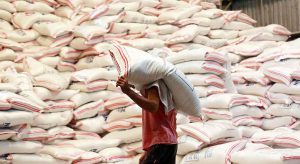A RICE shortage is looming if the government does not address rising input costs and low farmer incomes, rice industry analysts and representatives said.
“There is a threat that we might be lacking in rice. For us farmers, the first reason is because of low prices of palay (unmilled rice) and high input costs. Because of this, the harvest is not good. There is no motivation to harvest because farmers earn so little,” Teodoro C. Mendoza, agronomist and a retired professor affiliated with the Institute of Crop Science at the University of the Philippines Los Baños, said in an online forum on Wednesday.
“Expect rice prices to increase. We are conditioning people to expect that rice prices will increase,” he added.
The Alliance for Resilience, Sustainability and Empowerment (ARISE) in a statement called for an increase in the farmgate price of cleaned palay to P22 per kilogram and P25 for dried palay.
“Farmers would lose if their palay is bought at P19 per kilogram, which is the National Food Authority’s (NFA) current buying price,” it said, adding that the NFA price does not adequately compensate them for their labor.
Mr. Mendoza said that rice production has also been hampered by weather conditions and the conversion of farmland to roads or infrastructure.
“Farmers are not applying sufficient fertilizer due to its very high price. Even if there wasn’t a typhoon, prices would still rise because farmers could not put in sufficient fertilizer,” he said.
The price of a bag of urea fertilizer has risen to P2,850 from P1,000 pre-crisis, Mr. Mendoza said.
International rice prices have risen for the fifth straight month to a 12-month high, according to the United Nations Food and Agriculture Organization Food Price Index.
“The supply of rice is very tight. India usually supplies 21 million metric tons to over a hundred countries in the world. But now India won’t export rice because they were caught by the drought. Their policy is that the buffer stock is for one year. Here, it is for six days,” Mr. Mendoza said.
He also said land planted to rice is declining.
“How to stop land hemorrhage? Pass the National Land Use Act, implement the Agriculture and Fisheries Modernization Act of 1997, amend the local government code, and increase rice farmers’ income,” he said.
He said the availability of irrigation water is out of sync with the planting season.
“Farmers plant from early May to the first week of June. But they cannot plant early because rain is not sufficient to prepare the land, which is why fields need to be irrigated. We (should) criminalize the conversion of irrigated rice land,” he said.
“We are in the climate change era. We have to adjust planting times due to climate change. Strong typhoons are happening in September. By mid-September, rice should have been harvested,” he added.
According to ARISE, rice imports are projected to hit 3.9 million metric tons (MT) this year if the government does not intervene.
“The NFA’s recent pronouncement that it will raise its palay buying price to P21 per kilogram is a welcome move for many farmers. However, this needs to be followed up with concrete action from top to bottom,” the group said.
“The NFA has called for the support of legislators and (has asked) local government units (LGUs)… to engage in palay procurement. But NFA has also to increase its (procurement funds) capital and prepare the logistical support to enable LGUs to readily procure from farmers,” it added.
“We must save the rice industry. Saving the industry saves the rice farmers,” Mr. Mendoza added.
In a statement, the Department of Agriculture (DA) National Rice Program projected this year’s palay production at 19.5 million MT.
As of Sept. 15, the DA’s 2022 rice supply outlook estimated supply in the year to date at 17.36 million MT and consumption at 15.14 million MT.
“There will be an ending stock of 2.228 million MT equivalent to 60 days. The expected imports are 2.75 million MT for the first three quarters of the year,” the DA said.
“While all of the remaining issued import clearances by the Bureau of Plant Industry will only be valid until the third quarter and imports are yet to be estimated for the last quarter of this year, based on historical trends, import arrivals start to decline by the fourth quarter (to coincide with) the peak harvest from October to November,” it added.
The department said it is “confident” rice supply will be sufficient for the holidays.
According to the DA, the prevailing retail price for imported well-milled and regular-milled rice remain at P39 and P38 per kilogram, respectively. Domestically produced well-milled and regular-milled rice fetch P40 and P38 per kilogram, respectively.
For 2023, the DA said it is targeting production of 20.24 million MT of palay.
Separately, the Philippine Rice Research Institute (PhilRice) said it is promoting drone technology in rice farming to improve pest and nutrient management.
“Agricultural drones are used in aerial spraying of pesticides, fungicides, foliar fertilizers, and nutrients. Based on studies, using drone sprayer can reduce pesticide volume by up to 30-40%, minimize pilferage of chemicals, and save water up to 90%,” PhilRice said in a statement.
The agency also recommended drum seeders to improve farmers’ field practices and applications that aid in weed identification which also make crop management recommendations. — Luisa Maria Jacinta C. Jocson
